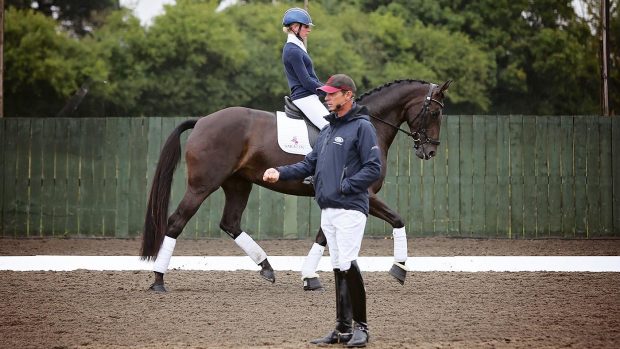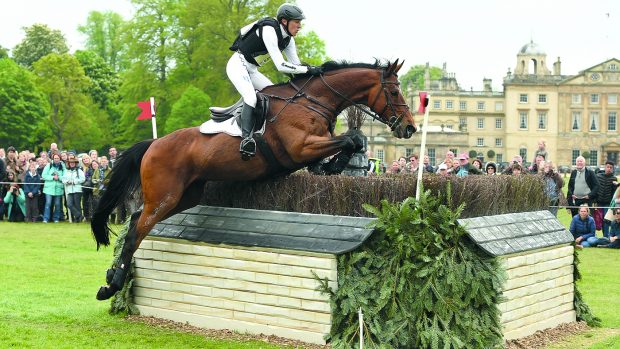Horse & Hound's dressage editor Alice Collins, who is currently competing at prix st georges level, shares her simple steps for achieving the perfect canter
1. Vary the pace of the canter
This is basic, but so important. Once the horse is going forwards into an even contact, start to vary the pace of the canter. When you bring the canter back, keep the energy level up, and be sure to give the rein often to teach the horse to carry himself in the collection. It serves a double function; releasing pressure as a reward, and also creating self-carriage.
Initially, this can be just a stride or two of slower canter, but build this up over time as the horse develops strength and carrying power. Intersperse the more collected canter with a forward, active canter. Ensure the activity in the hindleg doesn’t die when collecting the canter. If it does, re-energise it by riding a few strides powerfully forward.
Ensure he doesn’t fall on his face or land in a puddle on the forehand in the bigger canter, getting heavy on your hand. If that happens, ride fewer strides of the bigger canter before bringing the pace back — maybe just three or four.
You should aim to be able to ‘rock’ the horse between your leg and hand, using your seat to allow for a bigger stride or bring it back.
2. Focus on straightness
Once you are satisfied that the horse has a sufficient degree of self-carriage and correct collection in the canter — and this won’t happen overnight — you can concentrate on the straightness.
Horses naturally go quarters-in in canter, so in any type of canter going large round the edge, you need to imagine the inside hindleg stepping up towards the centre of the chest. To do this, you’ll need to bring the shoulders off the track a little. You’ll need control over the shoulders in canter for riding centre lines at the higher levels, so it’s important to start this positioning from early in their training.
Ride down the long side in shoulder-fore. You should be able to do this without having to wrestle the shoulders off the track. If you are struggling, the horse is probably trying to stick to the track with his shoulders. Try lifting your outside hand and taking a little counter-flexion to encourage the shoulders off the track. Once they are positioned correctly, retake the slight bend to the inside, without letting the shoulders slide back to the track.

Once you can ride down the long side in shoulder-fore, try riding the second half of the side with the quarters slightly in. Make sure you straighten the horse (ensuring the inside hind is back underneath him) before the corner, otherwise he will free-wheel round crooked.
Progress this exercise so you can change (gently) between shoulder-fore and quarters-in (AKA travers) three or four times on the long side. Then try it on the inner stack, making sure you are in full control of the shoulders and the quarters. Make sure you ride it on both reins.
Continued below…
If you enjoyed this, you might also enjoy reading these articles…
Does seeing female competitors without hairnets make your

25 signs you’re an incurable dressage diva/divo
3. Start to collect the canter with quarters in
Now you have a straight, positionable horse who is cantering evenly into both reins, a great exercise for improving the collection and building sitting power is starting to collect the canter with quarters in.
But don’t be temped to try to ride a grand prix pirouette when the horse is just learning the work.
First, take the quarters-in exercise into a circle of about 18m, so a large one, but not so large that the horse can rely on the wall or fence at the edges. Ride half the circle in quarters-in, half in shoulder-in.
If the horse is reluctant to bring the shoulder round and wants to banana in with the quarters, take counter flexion and push the quarters out. Some horses will find this really hard, so don’t bend them too much; just flex them at the poll.
This exercise is really hard work for many horses, so don’t hold them in it for too long with unrealistic expectations, especially during the early learning stages.
As the horse’s understanding deepens and its strength builds, make the circle smaller. You should still be able to ride either in travers or shoulder-fore, as you wish.
And finally… If your horse can do all the above, book him into a show. ASAP.
Why you won’t want to miss the H&H Festival of Dressage…
The Horse & Hound Festival of Dressage is a three-day unaffiliated competition featuring championship classes from intro to medium level, as well as warm-up and evening freestyle competitions. It is being held at Sheepgate Equestrian, Lincs on 20-22 July. There will be a prize fund of about £1,000 per level, including winners’ rugs and top-quality prizes. And as well as the dressage, competitors are invited to a drinks reception on the Friday, a hog roast on the Saturday and more evening entertainment, giving all the buzz of a stay-away championship. Find out more >>
Don’t miss our dressage special issue of Horse & Hound magazine, out now (23 March 2017), including our exclusive interview with Isabell Werth




